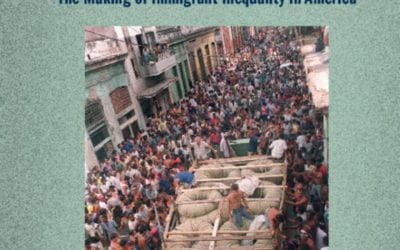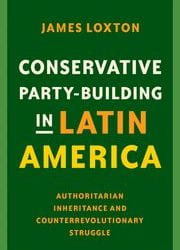Living within the Collapsed Myth of Multiculturalism
Afro-descendent Women during Covid-19
On July 28th, Peruvian independence day, I had just finished listening to the two-hour presidential speech discussing the government response to the country’s multiple crises. I headed out to meet Rosita, as she prefers to be called, at noon while she delivered a lasagna to a retired colonel living around the corner from the house she worked in. At 70, she was caring for a 95 year old woman despite having knee problems. She had been previously employed for more than 30 years as a full time housekeeper for a Spanish lawyer who died in 2017 and was in no position to reject work offers. So as Peru celebrated 199 years of independence and 166 years of official abolishment of slavery, Rosita was working at significantly below minimum wage an overnight shift that involved cleaning her employer’s bottom and taking care of her every need.
As I listened to the speech before meeting with Rosita, I was struck by the fact that the president left out the plight for survival of Peru’s indigenous populations, often portrayed as distant and almost foreign. Most unsurprisingly, the speech failed to acknowledge the needs and demands from the Afro-Peruvian people who have been experiencing increasingly precarious conditions, despite their large presence in Lima. “Indigenous populations are seen as their own people for being far away from the capital, but because Afro-Peruvians live on the coast, we are not taken into account as a population with pressing needs. There aren’t neighborhoods of Afro-Peruvians as we are scattered amongst the most segregated districts,” said Angie Campos, an Anthropology Ph.D. candidate and activist I met in early June.
As an independent photographer born and raised in Lima, I felt the urgency to document the daily lives of women of different ages and backgrounds starting in late May as I began realizing the worldwide protests were not resonating with Peruvian society at large. Throughout the documentary process, it became apparent to me how Afro-descendent women were being impacted economically and psychologically by the Covid-19 crisis, in particular inside their own homes. “The only governmental entity that mentions Afro Peruvians, is the Ministry of Culture. As if we only exist to contribute to Peru’s cultural image without addressing that we were already living through systemic crises,” said Melody Palma, a law graduate and activist, in a mid-August video conversation. “Everyone talks about the doctors working in the front lines but there is no talk about the Afro-Peruvian women living in the frontlines.”
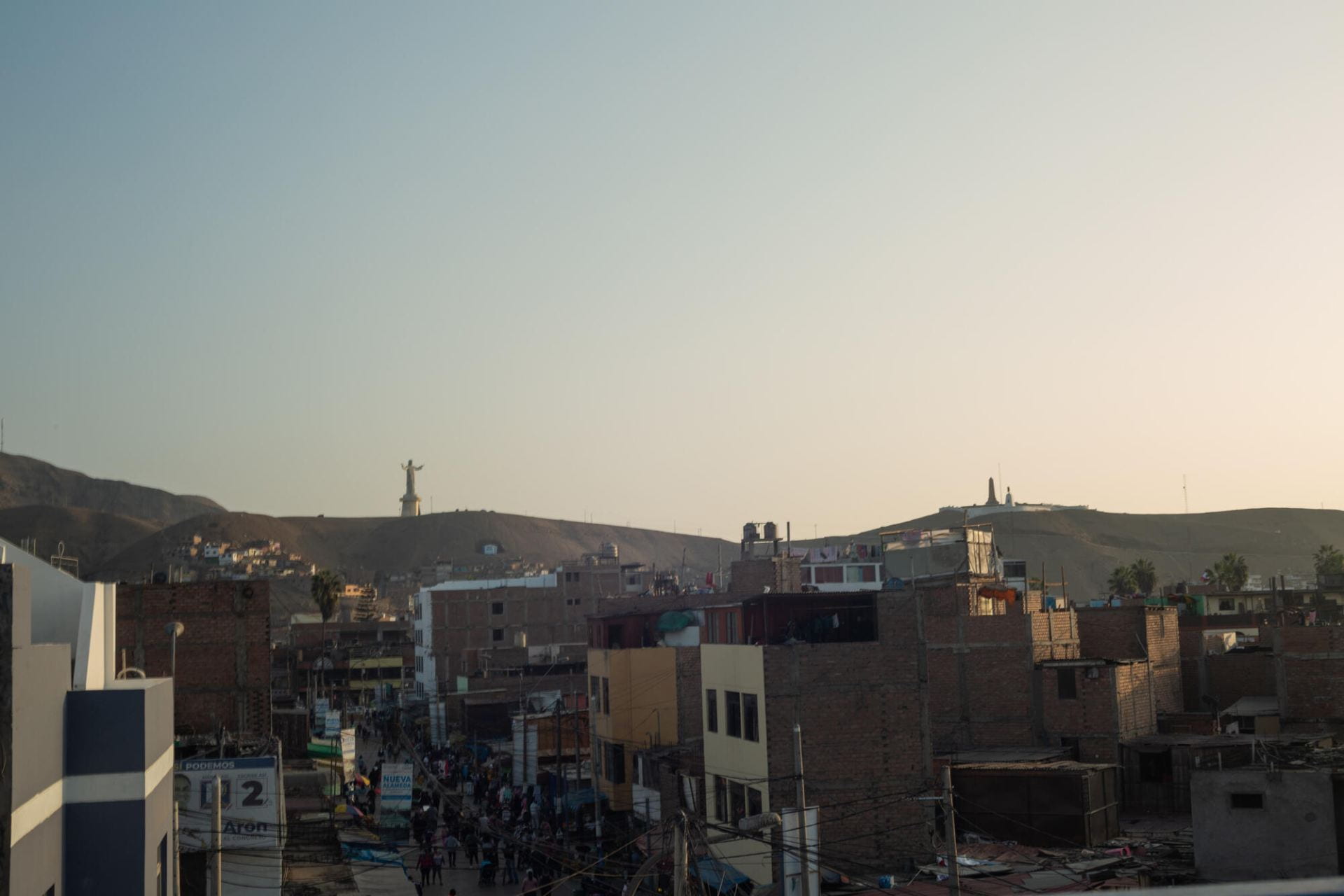
Late afternoon in the district of Chorrillos, where Rosita grew up and where a few of the other women live.
Around May 28, a heated debate arose as the Ministry of Culture published specific health guidelines for Afro-descendents and on June 22, the Alicorp company announced their removal of the figure Negrita, similar to Aunt Jemima. Both instances were received with indignation and arguments stating these decisions were unnecessary especially with the Covid-19 crisis. As worldwide experts have noted, racism and segregation does contribute to the increasing health crisis. Making Peru no different but instead highlighting a complicated national narrative.
Talking about this subject has proven to be as unpopular as it can get, along with a significant lack of intersectional studies and statistics available. Most Peruvians still hold onto a narrative of multiculturality as a national identity without realizing the extent that it fogs and distracts from all efforts of engaging in thoughtful and proactive change. “Many women have not gone to the hospital or clinic out of fear they will be treated worse than they were before Covid-19,” said Campos. As a Peruvian myself, it was upsetting to understand this sense of multicultural pride contributes to a lack of sensitivity and enables recurring arguments such as “we are all the same,” “they are just resentidos sociales” or “racism doesn’t exist”.
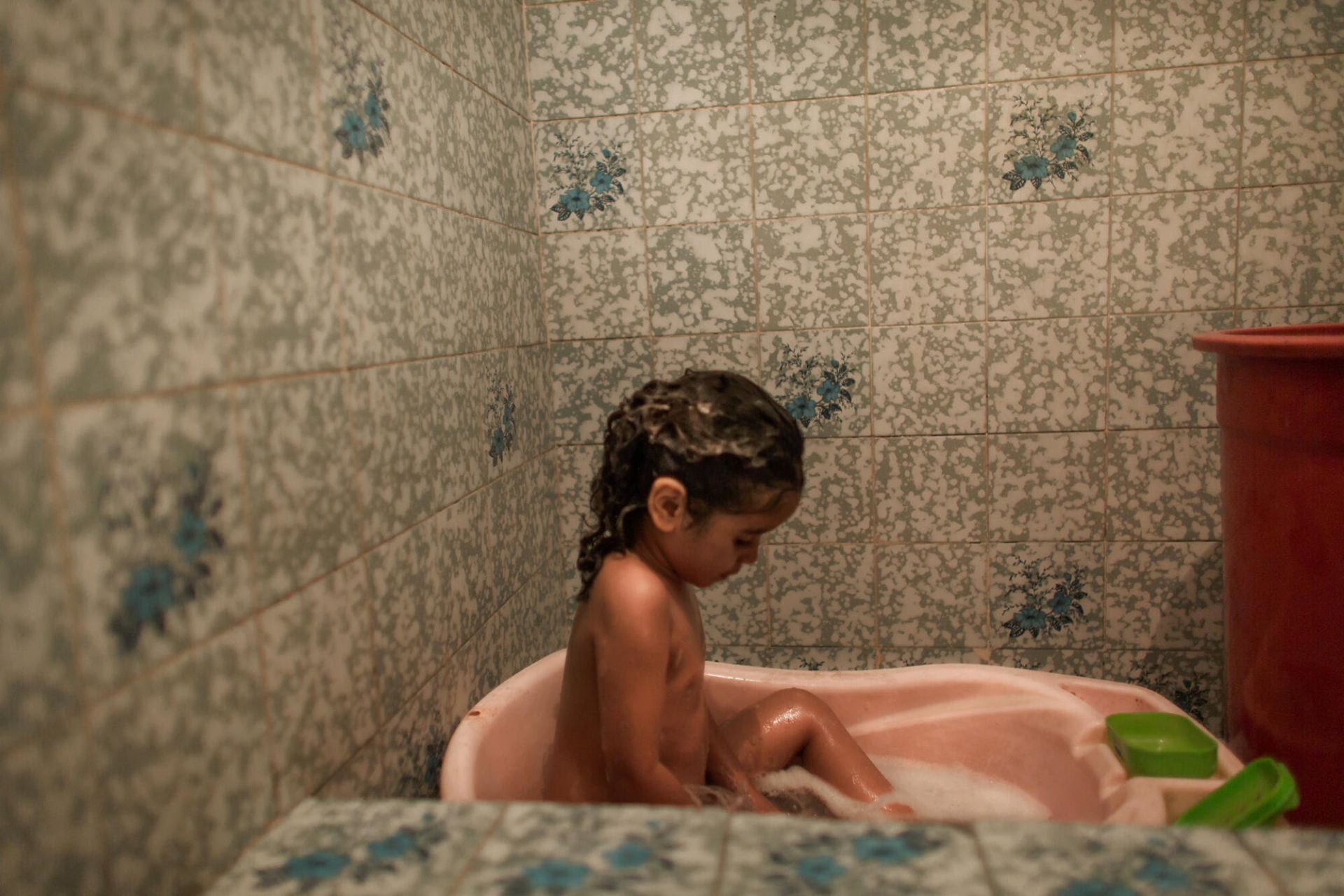
One of the youngest members of one of the families in Chorrillos, waiting for her mother to come back with the boiled water for her bath. Most of the houses in the neighborhood don’t have water heaters and she spent more time playing than bathing, cooling down the tempered bath.
Consequently, leaving aside the pain of being confused for a prostitute (this happened to one of the women going back home from the bodega), the frustration of not being able to access basic healthcare services or the denigration of being impersonated and mocked on national television and social media (the most recent case was of a Peruvian athlete painting her face as a stereotyped Andean woman on Instagram in mid August). Within a society of normalized machismo and sexist violence, non-white women are still perceived and expected to act as servants, maids, objects of entertainment or of pleasure. A story that repeats itself for Afro-descendents, indigenous women and even Venezuelan migrants, with haunting testimonies of being followed, harassed, abused or confused for prostitutes purely for their physical appearance. Having spent January through March doing photo documentary work with Venezuelan women in Lima, it was eerie to find many similarities between the experiences of Afro-descendent women with forced migrants.
Afro-Peruvian culture is very alive and present in our day-to-day lives which led me to be surprised by how difficult dialogue turns when asking to be recognized as active parts of Peruvian society and for a structural reform in the way we relate to each other. “You can be friends with someone that calls you negrita but if there is ever an argument or a fight, race is brought up as an insult. As if the color of your skin is insulting,” said one of the mothers involved in the project. What stood out from our conversations was the common feeling of exhaustion. An exhaustion that each woman managed differently and was not correlated to the degree to which they challenged the status quo. In Lima, the status quo for most women is very similar to that of our time as a Spanish colony, with the role of serving and sustaining the household with the myth that she could take on anything and everything. For racialized (non-white looking) women, the full emphasis went towards serving.

Sunday morning, preparing breakfast for 13 people inside one of the homes of Chorrillos. She is the mother of the young girl inside the bath. She works from 6.30am to 3pm in the local Military Hospital as maintenance staff and then returns home where she is in charge of her two children, their meals and keeping the household clean.
Lima is a large city with only 6.8% of people who identify as Afro-Peruvian nation-wide, suggesting that many women for various reasons do not identify as such. With or without the political identification, our conversations reflected they felt isolated and some still felt uncomfortably aware of their bodies. Some of the older women described themselves as mestiza or felt more comfortable with terms such as zamba or morena (terms related to colonial concepts of castes which are more generally accepted than saying negra and which establishes a manageable psychological distance from the racial violence experienced, explained Campos). As a consequence of the daily harassment and economic difficulties, most of the women I documented believed they did not belong in academic spaces. A study done by CEDET with UNICEF and Plan International in 2013 showed that an estimated 20% of Afro Peruvian girls and young women drop out of school because they didn’t like it. As of the recent 2017 census, only 11.5% of Afro Peruvian women pursued higher education.
Many of these women did not have a choice about what became their life stories. Rosita, for example, was sent to a convent at 14 because her mother was afraid she would be harassed or raped like her younger sister later was and at 18 she wanted to study to become a nun but had to start working to help her mother raise her nine younger siblings. “What happens to a woman when you tell her she has a choice for what her life can be and suddenly her whole identity of having to serve and take care of others, is taken away from her?” said Campos, whose work is dedicated to the personal and political growth of the Afro-Peruvian population. ”It’s a process that takes time.”

One of the sisters of a different household (left) with her niece (right) taking orders from customers that come to buy homemade food and beers on a Sunday afternoon in June.
It is very tempting to paint the Peruvian experience with a single brush under the umbrella term of Latin American. However the story of multiculturality easily overlooks stories such as Rositas and exacerbates apathy. Stories that are so common and normalized within the society I grew up in, that too few bat an eye at the idea of an elderly woman having to commute to work as a carer of an even older woman whenever she needs her during the day or overnight without health insurance or a proper salary.
As the project expanded to more women and other life stories, I was astonished that a few people I spoke with asserted that the conversation about race is a foreign trend that does not apply to our country. I believe that we as Peruvians desperately need to be more active in relating to each other’s experience and to be willing to be uncomfortable, just as people in the United States or in Europe are in regards to the issue of race. “Peru is still taking baby steps,” Campos observed. Despite the fact the Afro-Peruvian movement began in the 1980s and we all have felt the impact of the recent Black Lives Matter protests.
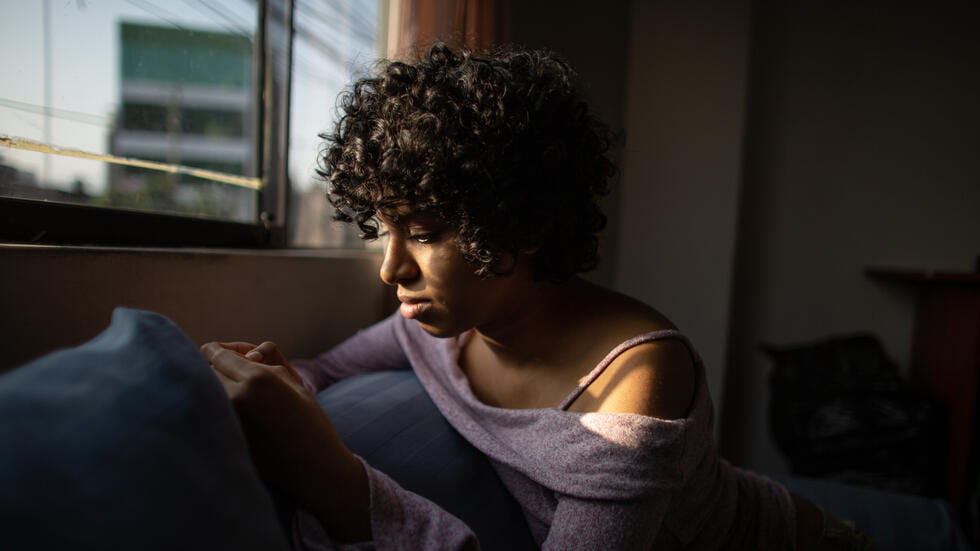
19 year old sociology student, inside her grandmother’s bedroom which is adjacent to her family house in the northern district of Lima, San Juan de Lurigancho. She, along with some friends, created a university group of Afro Peruvian studies, along with the youth activism she participates in.
Much of the local Afro-feminist activism happens through social media, and with Covid-19 I was venturing out to specific home addreses up until the end of July, as the situation got worse within the city. Peru has been heavily impacted with 72.5% of the population working informally; with 164,476 confirmed cases and 4,506 deaths by the 31st of May and with 407,492 cases and 19,021 deaths by the 31st of July (Ministry of Health). With the restrictions that took place, most of the women documented could not afford to stay quarantined and had been working in and out of their homes before it was officially lifted on the 30th of June. Unfortunately, there are no statistics or recent studies available on the impact of these last few months on Afro-descendents.
These last few months raised more questions than answers about the experiences and foreseeable futures of Afro-descendent women in Peru, despite the activism taking place in Latin America and worldwide. With a significant lack of studies or investigations, I wonder how much of Peru’s development would continue or be further stunted without an active governmental and societal reckoning of the self inflicted pain caused through stereotyping and adhering to judgements which only achieve further divisions. Within the desert that is Lima, I wonder if these women would be taken into account if we begin experiencing drastic environmental challenges such as water scarcity or if this would exacerbate the already existing stereotypes and gendered-violence. As we have seen, it will be the women responding to these foreseeable crises, while cooking, feeding, cleaning, bathing their children, running errands, working and hoping they will be well enough physically to repeat the same thing the next day. Something already happening with Covid-19.
Viviendo dentro del Mito Colapsado del Multiculturalismo
Mujeres afrodescendientes durante Covid-19
Por Daniela Rivera Antara
El 28 de julio, día de la independencia del Perú, acababa de terminar de escuchar el discurso presidencial de dos horas sobre la respuesta del gobierno a las múltiples crisis del país. Salí a encontrarme con Rosita, como prefiere que la llamen, al mediodía mientras le entregaba una lasaña a un coronel jubilado que vivía a la vuelta de la esquina de la casa en la que trabajaba. Con 70 años, estaba cuidando a una mujer de 95 años a pesar de tener problemas de rodilla. Anteriormente había trabajado por más de 30 años como ama de llaves a tiempo completo para un abogado español que murió el 2017 y no estaba en condiciones económicas de rechazar ofertas de trabajo. Así que mientras Perú celebraba 199 años de independencia y 166 años de abolición oficial de la esclavitud, Rosita trabajaba por muy debajo del salario mínimo en un turno de noche que implicaba limpiar el trasero de su empleadora y atender todas sus necesidades.
Antes de reunirme con Rosita, mientras escuchaba el discurso, me sorprendió que el presidente deje de lado la difícil situación de supervivencia de las poblaciones indígenas, a menudo retratadas como distantes y casi foráneas. Además, el discurso dejó de lado las necesidades y demandas del pueblo afroperuano que ha estado experimentando condiciones cada vez más precarias, a pesar de su presencia importante en Lima. “Las poblaciones indígenas son vistas como su propio pueblo por estar lejos de la capital, pero debido a que los afroperuanos vivimos en la costa, no se nos toma en cuenta como una población con urgencias. No hay barrios de afroperuanos porque estamos dispersos entre los distritos más segregados ”, dijo Angie Campos, candidata a Ph.D. en Antropología y activista que conocí a principios de junio.
Como fotógrafa independiente nacida y criada en Lima, sentí la urgencia de documentar la vida cotidiana de mujeres de diferentes edades y contextos familiares a partir de finales de mayo cuando comencé a darme cuenta de que las protestas internacionales no estaban resonando en la sociedad peruana por lo general. A lo largo del proceso documental se me hizo evidente cómo las mujeres afrodescendientes estaban siendo impactadas económica y psicológicamente por la crisis de Covid-19, en particular dentro de sus propios hogares. “La única entidad gubernamental que menciona a los afroperuanos es el Ministerio de Cultura. Como si solo existiéramos para contribuir a la imagen cultural del Perú sin abordar que ya vivíamos varias crisis sistémicas”, dijo Melody Palma, licenciada en derecho y activista, en una conversación por video a mediados de agosto. “Todo el mundo habla de los médicos que trabajan en primera línea, pero no se habla de las mujeres afroperuanas que viven en primera línea”.

Late afternoon in the district of Chorrillos, where Rosita grew up and where a few of the other women live.
Alrededor del 28 de mayo se generó un debate cuando el Ministerio de Cultura publicó especificaciones de salud para afrodescendientes y el 22 de junio la empresa Alicorp anunció la eliminación de la figura Negrita, similar a Aunt Jemima. Ambas instancias fueron recibidas con indignación y con argumentos que afirmaban que estas decisiones eran innecesarias, especialmente con la crisis de Covid-19. Como han señalado los expertos por el mundo, el racismo y la segregación contribuyen a la creciente crisis de salud. Cosa que no hace que Perú sea diferente, sino que en vez resalta una narrativa nacional complicada.
Hablar sobre el tema de racismo ha demostrado ser poco aceptado, junto con una falta significativa de estudios interseccionales y estadísticas disponibles. La mayoría de los peruanos todavía se aferran a la narrativa de multiculturalidad como identidad nacional sin darse cuenta que distrae de todos los esfuerzos de implementar cambios proactivos. “Muchas mujeres no han ido al hospital o la clínica por temor a que las traten peor que antes del Covid-19”, dijo Campos. Siendo peruana, fue decepcionante entender que este orgullo multicultural contribuye a la falta de sensibilidad y exacerba argumentos recurrentes como “todos somos iguales”, “son resentidos sociales” o “el racismo no existe”.

One of the youngest members of one of the families in Chorrillos, waiting for her mother to come back with the boiled water for her bath. Most of the houses in the neighbourhood don’t have water heaters and she spent more time playing than bathing, cooling down the tempered bath.
Por consecuencia, dejando a un lado el dolor de ser confundida por prostituta (esto le pasó a una de las mujeres que volvía a su casa de la bodega), la frustración de no poder acceder a servicios básicos de salud o la denigración de ser la cara de burlas en la televisión nacional y redes sociales (el caso más reciente fue el de una atleta peruana que se maquilló como una mujer andina estereotipada y lo publicó en Instagram a mediados de agosto). Dentro de una sociedad de machismo normalizado y violencia sexista, las mujeres racializadas (no blancas) aún se perciben y se espera que actúen como sirvientas, empleadas, objetos de entretenimiento o de placer. Una historia que se repite para afrodescendientes, mujeres indígenas e incluso migrantes venezolanas, con testimonios inquietantes de ser seguidas, acosadas, abusadas o confundidas por prostitutas simplemente por su apariencia física. Habiendo dedicado de enero a marzo para un trabajo foto-documental con mujeres venezolanas en Lima, fue inquietante encontrar similitudes entre las experiencias de las mujeres afrodescendientes con migrantes forzadas.
La cultura afroperuana está muy viva y presente en nuestro día a día lo que me llevó a sorprenderme de lo difícil que se vuelve el diálogo al pedir ser reconocidas como parte activa de la sociedad peruana y al pedir una reforma estructural en cómo nos relacionamos el uno con el otro. “Puedes ser amiga de alguien que te llama negrita, pero si alguna vez hay una discusión o una pelea, usan la raza como un insulto. Como si el color de tu piel fuera un insulto”, dijo una de las madres involucradas en el proyecto. Lo que sobresalió de nuestras conversaciones fue el sentimiento común de cansancio. Un cansancio que cada mujer maneja de manera diferente y que no se correlacionó con el grado en que desafían el status quo. En Lima, el status quo para la mayoría de las mujeres es muy similar al de nuestra época como colonia española, con el papel de servir y sostener al hogar con el mito de que ella podía asumir cualquier cosa a todo momento. Para las mujeres racializadas, el énfasis es hacia el servicio.

Sunday morning, preparing breakfast for 13 people inside one of the homes of Chorrillos. She is the mother of the young girl inside the bath. She works from 6.30am to 3pm in the local Military Hospital as maintenance staff and then returns home where she is in charge of her two children, their meals and keeping the household clean.
Lima es una ciudad grande con solo el 6,8% de personas que se identifican como afroperuanas en todo el país, lo que sugiere que muchas mujeres por diversas razones no se identifican como tales. Con o sin la autoidentificación política, nuestras conversaciones reflejaban que se sentían aisladas y algunas todavía se sentían incómodamente conscientes de sus cuerpos. Algunas de las mujeres mayores se describieron a sí mismas como mestizas o se sintieron más cómodas con términos como zamba o morena (términos relacionados con conceptos coloniales de castas que son más aceptados que decir negra y que establecen una distancia psicológica manejable con la violencia racial vivida, explicó Campos).
Como consecuencia del acoso diario y las dificultades económicas, la mayoría de las mujeres que documenté creían que no pertenecían dentro de espacios académicos. Un estudio realizado por CEDET con UNICEF y Plan International en 2013 mostró que aproximadamente el 20% de las niñas y jóvenes afroperuanas dejaban la escuela porque no les gustaba. Según el censo del 2017, solo el 11,5% de las mujeres afroperuanas cursaban estudios superiores.

One of the sisters of a different household (left) with her niece (right) taking orders from customers that come to buy homemade food and beers on a Sunday afternoon in June.
Muchas de estas mujeres no tuvieron elección sobre lo que se convertiría en sus historias de vida. Rosita, por ejemplo, fue enviada a un convento a los 14 porque su madre temía que la acosaran o la violaran (como después le pasó a su hermana menor) y a los 18 quería estudiar para ser monja pero tuvo que empezar a trabajar para ayudar a su mamá a criar a sus 9 hermanos menores. “¿Qué le sucede a una mujer cuando le dices que puede elegir lo que puede ser su vida y de repente le quitas su identidad de tener que servir y cuidar a los demás?” dijo Campos, cuyo trabajo está dedicado al crecimiento personal y político de la población afroperuana. “Es un proceso que toma tiempo”.
Es muy tentador pintar la experiencia peruana con un solo pincel bajo el término general de latinoamericano. Sin embargo, la historia de la multiculturalidad fácilmente pasa por alto historias como la de Rosita y exacerba la apatía. Historias que son tan comunes y normalizadas dentro de la sociedad en la que crecí, que muy pocos se inmutan ante la idea de una mujer mayor yendo a trabajar como cuidadora de una mujer aún más mayor cuando la necesita durante el día o durante la noche sin seguro de salud ni un salario adecuado.

19 year old sociology student, inside her grandmother’s bedroom which is adjacent to her family house in the northern district of Lima, San Juan de Lurigancho. She, along with some friends, created a university group of Afro Peruvian studies, along with the youth activism she participates in.
A medida que el proyecto se expandió a más mujeres y otras historias de vida, me sorprendió que algunas personas con las que hablé afirmaron que la conversación sobre la raza es una tendencia extranjera que no se aplica a nuestro país. Me llevó a pensar que los peruanos necesitamos desesperadamente ser más activos al relacionarnos con las varias historias que existen dentro del país y estar dispuestos a sentirnos incómodos, al igual que en los Estados Unidos o en Europa con respecto al tema de la raza. “Perú todavía está dando sus primeros pasos”, observó Campos. A pesar de que el movimiento afroperuano comenzó en los años 80 y todos hemos sentido el impacto de las recientes protestas de Black Lives Matter.
Gran parte del activismo afrofeminista local ocurre a través de las redes sociales, y con Covid-19 me aventuré a direcciones de casas específicas hasta finales de julio cuando la situación empeoró dentro de la ciudad. Perú se ha visto muy afectado con un 72,5% de la población que trabaja de manera informal; con 164.476 casos confirmados y 4.506 fallecimientos para el 31 de mayo y con 407.492 casos y 19.021 fallecimientos para el 31 de julio (Ministerio de Salud). Con las restricciones puestas, la mayoría de las mujeres documentadas no podían permanecer en cuarentena y habían estado trabajando dentro y fuera de sus hogares antes de que se levantara oficialmente el 30 de junio. Lamentablemente, no existen estadísticas o estudios recientes disponibles sobre el impacto de estos últimos meses en los afrodescendientes.
Estos últimos meses me dieron más preguntas que respuestas sobre las experiencias y el futuro previsible de las mujeres afrodescendientes en Perú, a pesar del activismo concurrente dentro de América Latina y del mundo. Con una falta significativa de estudios e investigaciones, me pregunto cuánto del desarrollo del Perú continuaría o se vería aún más afectada sin un reconocimiento activo gubernamental y social del dolor autoinfligido causado por los estereotipos y la adhesión a juicios que solo logran más divisiones. Dentro del desierto que es Lima, me pregunto si estas mujeres serían tomadas en cuenta si comenzamos a experimentar desafíos ambientales más drásticos como en la escasez de agua o si esto exacerbaría los estereotipos y la violencia de género ya existentes. Como hemos visto, serán las mujeres las que responderán a estas crisis previsibles, mientras cocinan, alimentan, limpian, bañan a sus hijos, hacen las compras, trabajan y esperan estar lo suficientemente bien físicamente para repetir lo mismo al día siguiente. Algo que ya está sucediendo con Covid-19.
Daniela Rivera Antara is a multidisciplinary artist, photographer and writer on intersectional issues related to gender, environment and identity. She has been published by The Guardian and hopes to begin her MA on Women and Environmental Sustainability. www.dra.com.pe
Contact: daniela.rivera2707@gmail.com
Daniela Rivera Antara es una artista multidisciplinaria, fotógrafa y escritora sobre temas internacionales relacionados a género, medio ambiente e identidad. Ha sido publicada por The Guardian y espera comenzar su maestría en Mujeres y Sostenibilidad Ambiental. www.dra.com.pe
Related Articles
A Review of Cuban Privilege: the Making of Immigrant Inequality in America by Susan Eckstein
If anyone had any doubts that Cubans were treated exceptionally well by the United States immigration and welfare authorities, relative to other immigrant groups and even relative to …
A Review of Conservative Party-Building in Latin America: Authoritarian Inheritance and Counterrevolutionary Struggle
James Loxton’s Conservative Party-Building in Latin America: Authoritarian Inheritance and Counterrevolutionary Struggle makes very important, original contributions to the study of…
Endnote – Eyes on COVID-19
Endnote A Continuing SagaIt’s not over yet. Covid (we’ll drop the -19 going forward) is still causing deaths and serious illness in Latin America and the Caribbean, as elsewhere. One out of every four Covid deaths in the world has taken place in Latin America,...


